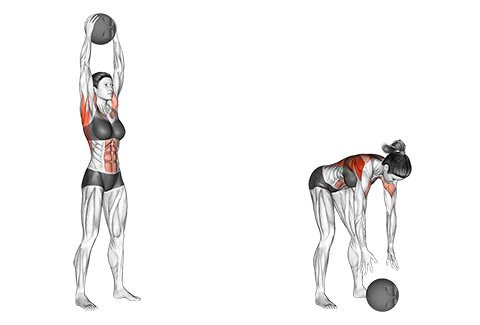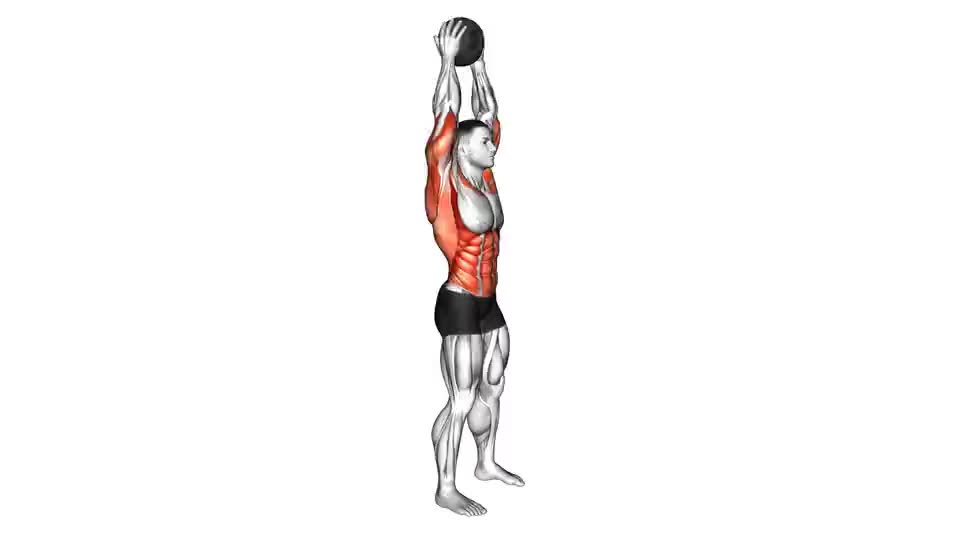Medicine ball slams didn’t mean much to me at first. I used to see them sitting in the corner of the gym and figured they were just for warmups or group classes. You know — one of those things people throw around to look busy.
Then I actually used them.
A coach threw them into one of my power sessions. And that was it — I was sold. Medicine ball slams weren’t just a filler exercise. They hit hard, they worked everything, and they made sense for what I was training for: speed, explosiveness, and power on the gym floor.
If you’re serious about sprinting or jumping — or you’re building out programming for a commercial gym — this is one move I wouldn’t sleep on. But a lot of people still don’t really get how to use it. So here’s how I break it down.
What Medicine Ball Slams Are And Why They Work
Medicine ball slams are a powerful full-body movement where you lift a ball overhead and slam it into the ground with force.
It looks simple, but it trains explosive power, core control, and force absorption — all key for sprinting, jumping, and athletic performance.
Not just cardio. Not just core. It’s real power work — fast, aggressive, and perfect for the gym floor.

How I Actually Do a Medicine Ball Slam
Here’s exactly how I coach them — and how I run them myself in commercial gym settings:
- Start position
Stand with feet about shoulder-width firstly. Ball’s on the floor in front of you. - Lift
Squat down then. Pick it up with a flat back. Drive it overhead like you mean it — hips and legs extend all the way up. - Slam
Throw it down hard, like you’re trying to leave a dent in the floor. Aim just in front of your toes. - Follow through
Don’t stop short. Let your arms and chest follow the slam. Full body movement finally. - Reset
Don’t rush into the next rep regardless. Take a breath. Reposition. Go again with intent.
One big rule: Use a slam ball, not a bouncy wall ball. I’ve seen enough rebounds to know better.
What It Hits
It’s not just core. You’re lighting up multiple chains at once:
- Glutes & hammies — from that full hip drive
- Lats, shoulders, triceps — the throw and slam
- Core — big time. You’re resisting flexion and extension
- Grip & forearms — especially with a grippy rubber ball
So yeah, it’s basically full-body power in one clean move.
Why It’s Worth Your Time
If you coach or train athletes — especially sprinters or jumpers — slams make a lot of sense.
Here’s what I’ve seen:
- They help train rate of force development — the speed you can go from nothing to max output
- They reinforce triple extension — ankles, knees, hips firing together
- They build reactive core control — under real speed
- They improve power output — without the heavy barbell load
Bottom line? Faster sprint starts. Cleaner first steps. More vertical pop. Better ground reaction. All with zero spinal compression.
Real Talk: Tips, Technique & What NOT to Do
You’d be surprised how many people butcher this simple move. So here’s the checklist I use:
- Think power, not speed — don’t race through reps
- Slam into the floor, not your face — use a dead-bounce ball
- Don’t round your back when picking up the ball
- Don’t just use your arms — power comes from your legs and hips
- Reset each rep — if it’s clean and heavy, 5–8 reps is plenty
If it looks like a dance move, you’re probably doing it wrong. If it looks like controlled chaos, you’re close.
How Often to Train Slams and How Much
One of the first things I wondered was — how often should I actually do medicine ball slams? Too much, and you fry your nervous system. Too little, and you won’t see the carryover.
Here’s what’s worked for me and the athletes I’ve worked with:
| Goal | Sets | Reps | Ball Weight | How Often |
|---|---|---|---|---|
| 🔹 Max Power | 3 | 3–5 | 8–12kg | 2x / week |
| 🔹 Speed/Explosiveness | 2–3 | 6–8 | 4–6kg | 2–3x / week |
| 🔹 Conditioning/Blend | 3–4 | 10–12 | 2–4kg | 1–2x / week |
My tip: I like using slams after my sprint drills or Olympic lift primers. That way, I’m already warm and firing fast.
Also — I never throw them in at the end just to gas out. These work best when you’re fresh and focused. Think quality reps, not junk volume.
If you’re using them with clients on the gym floor, just match the intensity to the goal. Heavy and clean for power. Lighter and snappy for speed.
Slam Variations I Actually Use
Look — standard medicine ball slams are great. But if you want to mix things up, target different patterns, or just keep your athletes more engaged, adding a few variations goes a long way.
Here are a few I’ve actually used on the gym floor — either for sprint prep, jump work, or conditioning blocks:
Medicine Ball Thruster to Slam
This one’s spicy.
- Squat with the ball → press it overhead → slam it hard
- It’s full-body and gets the heart rate up
- Great for warmups or work capacity sets
Slam + Burpee Combo
It’s exactly what it sounds like:
- Slam the ball
- Drop into a burpee
- Pop up and repeat
Brutal. I’ll use this in group classes for metabolic finishers — or if I’m just feeling chaotic.
Rotational Slam
This one hits different:
- Stand slightly turned to one side
- Rotate through the hips as you slam across your body
It’s a solid move for rotational athletes — or anyone who needs better hip speed and trunk rotation. (So… almost everyone.)
Tall Kneeling Slam
- Kneel down
- Slam without using your legs
Sounds simple, but it’ll light up your upper body and core. Super strict. No cheating.
Split Stance Slam
This one’s a balance check:
- Set up in a split stance firstly (like a lunge)
- Slam the ball and hold your position
Great for stability under force. I use this with clients who need to stay grounded while still being explosive.
I’ll usually rotate in 1–2 of these each week depending on the goal. No need to overdo it — the basics still work. But adding a little variety? That keeps things sharp and fun.
Medicine Ball vs. Slam Ball
Let’s clear this up — not all “medicine balls” are built for slamming. I’ve seen way too many explode mid-session because someone grabbed the wrong type of ball.
Here’s the quick breakdown e.g.:
| eature | Medicine Ball | Slam Ball |
|---|---|---|
| Bounce | High or moderate | Dead bounce / no rebound |
| Shell | Softer or stitched panels | Tough rubber, usually textured |
| Best For | Throws, partner work, core | Slams, power work, durability |
| Durability | Medium (can tear/slip) | High (meant to take hits) |
My go-to: I stick with a 6–10kg slam ball, textured shell, and zero bounce. It just feels right for explosive power work. And also importantly — it doesn’t fight back.
Pro tip: Don’t use a wall ball for slams especially. Those are meant for throws at a wall — not the floor. I’ve watched them split wide open. Not fun to clean up.
If you’re building out a serious commercial space, just get a proper slam ball. Saves the not only equipment but also your face.
Medicine ball slams aren’t just some boot camp move — when you use them right, they’re a legit tool for sprint and jump performance. Lastly they’ve earned a spot in my training — and my athletes’ too.
So just remember: keep it clean, keep it powerful, and don’t waste reps.

Hi, I’m the editor here at Leadman Fitness. We’re a manufacturer focused on producing top-quality barbells, plates, kettlebells, dumbbells, and strength training gear. I’ve been into sports and fitness for years, and I know my way around all kinds of gym equipment—both from using it and helping create it.
I spend a lot of time understanding the real problems people run into in the gym—whether it’s beginners trying to pick the right gear or experienced lifters looking for something more durable. I stay in close touch with our production team and talk directly with other equipment makers, so we’re always improving based on what real lifters and coaches are looking for.
What I share comes from hands-on experience—stuff that actually helps people train better, not just in theory, but in real gyms.
